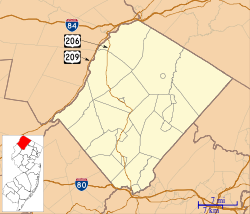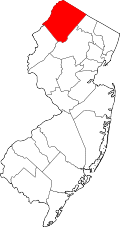Sussex County Courthouse (New Jersey)
 From Wikipedia - Reading time: 8 min
From Wikipedia - Reading time: 8 min
Sussex County Courthouse | |
 | |
| Location | High and Spring Streets, Newton, New Jersey |
|---|---|
| Coordinates | 41°3′32″N 74°45′14″W / 41.05889°N 74.75389°W |
| Area | 0.8 acres (0.32 ha) |
| Built | 1765 1847 (rebuilt) |
| Architect | Fowler & Andrews; Amos A. Harrison |
| Architectural style | Greek Revival |
| NRHP reference No. | 79001523[1] |
| NJRHP No. | 2618[2] |
| Significant dates | |
| Added to NRHP | July 23, 1979 |
| Designated NJRHP | May 9, 1979 |
Sussex County Courthouse is located at the corner of High and Spring Streets in Newton, the county seat of Sussex County, New Jersey in the United States. It is part 10th vicinage of the New Jersey Superior Court.[3][4]
It was originally built in 1765 and rebuilt in 1847.[5] It is one of the courthouses dating from the 18th century and among the oldest courthouses in the United States still in active use. It was added to the National Register of Historic Places on July 23, 1979 for its significance in architecture, using Greek Revival temple style.[6]
History
[edit]The courthouse was the site of a daring raid during the American Revolution by one of the Loyalists' best operatives, Lieutenant James Moody.[7] In 1780, Moody led several men to free eight Loyalist prisoners held in the Sussex County Courthouse. Moody freed the men and fled with them. Despite a pursuit lasting several days, Revolutionary forces failed to capture them. The court was gutted by fire in 1847 and rebuilt within the original fieldstone walls.[7]

The old courthouse continues to handle judicial proceedings in conjunction with a newer Sussex County Judicial Center built in 1992.[8][4][9]
See also
[edit]- County courthouses in New Jersey
- Richard J. Hughes Justice Complex
- National Register of Historic Places listings in Sussex County, New Jersey
- List of the oldest courthouses in the United States
References
[edit]- ^ "National Register Information System – (#79001523)". National Register of Historic Places. National Park Service. November 2, 2013.
- ^ "New Jersey and National Registers of Historic Places - Sussex County" (PDF). New Jersey Department of Environmental Protection - Historic Preservation Office. September 30, 2020. p. 5.
- ^ "Vicinage". Ballotpedia. Retrieved October 10, 2017.
- ^ a b "New Jersey Courts: Somerset/Hunterdon/Warren". State of New Jersey Department of Judiciary. Retrieved October 6, 2017.
- ^ Deacon, John. "American Courthouses Sussex". www.courthouses.co. Retrieved October 15, 2017.
- ^ Karschner, Terry (October 1978). "National Register of Historic Places Inventory/Nomination: Sussex County Courthouse". National Park Service. With accompanying 4 photos
- ^ a b Newton, NJ - The Sussex Court House
- ^ "Sussex". Courthouse History. Retrieved October 6, 2017.
- ^ "Sussex County Judicial Center". Emporis. Archived from the original on May 7, 2016. Retrieved October 6, 2017.
External links
[edit] Media related to Sussex County Courthouse (New Jersey) at Wikimedia Commons
Media related to Sussex County Courthouse (New Jersey) at Wikimedia Commons
 KSF
KSF


